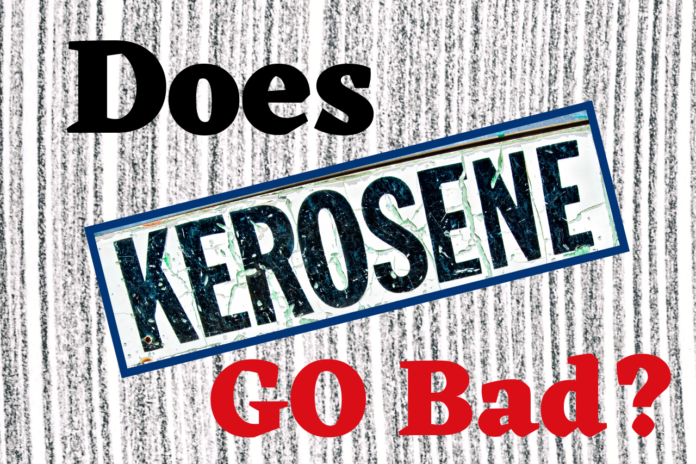You may already have some extra kerosene on hand but are concerned that Does Kerosene Go Bad? Knowing whether something goes bad, such as Kerosene, may save you time and money in the long run.
Kerosene is a highly flammable petroleum-based liquid. It, like other fuels, has its own set of hazards and complexities. Kerosene gets commonly used as a light or heating fuel on camping excursions and residences.
If the power goes out and you don’t have a generator, it’s a good idea for homeowners to have a backup plan. Kerosene lights and lanterns come in helpful in this situation.
Quick Summary: After Two to five years, condensation takes hold, and mold development occurs. As a general rule, consider Kerosene to be bad after five years. If you don’t store your Kerosene correctly, it might have a shelf life of fewer than two years.
Read the rest of the article. If you’re curious about the fuel you use frequently, we’ll explain the shelf life of Kerosene and whether or not it’s safe to use old Kerosene.
What Is Kerosene?
Kerosene is a highly flammable liquid made by fractional distilling crude oil. It comprises ten distinct hydrocarbons, each with 10 to 16 carbon atoms. Kerosene is typically non-viscous and transparent, but it may get used to making dense compounds like wax and other thicker substances.
Kerosene has managed to keep up with the times from the first reports of distillation in the 9th century. It gets widely used for both heating and electricity.
Fact: It gets estimated that between 200,000 and 250,000 rural enterprises rely on oil heating for space heating.
Although Kerosene’s applications range from oil lamp fuel to cleaning chemicals, jet fuel, heating oil, and cooking fuel, it is capable of far more than just two tasks. Furthermore, currently, the manufacture of kerosene oil is a simple operation.
Fact: A great Persian scholar named Muhammad ibn Zakariya al-Razi wrote the first known written documents regarding the kerosene distillation process.
In terms of properties, Kerosene is a highly flammable fuel with a boiling temperature ranging from 347 to 617 degrees Fahrenheit. Kerosene has a density of 0.80 grams per milliliter at an average temperature.
When the temperature drops, the viscosity rises. Water-insoluble, Kerosene is soluble in other petroleum solvents. This gasoline has a harsh odor to it. If unburned kerosene oil gets spilled, it emits a pungent stench.
Does Kerosene Go Bad?
Molds and bacteria can colonize Kerosene incorrectly kept, causing the fuel molecules to break down. Algae and bacteria develop in the water and feed on the fuel, resulting in gunky Kerosene that has a foul odor when burned. To address the question, Does Kerosene Go Bad? The answer is yes, it does.
Water contamination can cause the fuel to become diluted and lose its ability to create heat when left out for an extended time. Kerosene will ultimately go bad due to oxidation, even if there is no water pollution.
If you look up shelf life on the internet, you’ll get a plethora of results. Some claim 1-3 months, others a year, and even some claim up to 20 years.
Kerosene has a shelf life of 2 to 5 years, depending on how carefully it is stored.
Fact: Kerosene is less prone than gasoline or diesel to go bad.
How To Know If Kersosene Gone Bad?
If you know the answer to the question, “Does kerosene go bad?” and years have passed, there are several techniques to test for poor Kerosene.
- When Kerosene becomes stale, it becomes murky or yellow. You may see some sludge growing within the fuel, and it gets not recommended that you utilize it at this time
- Another approach to check its quality is to burn a tiny bit of it. The flame should be bright and even, and the stench should be mild while burning if the Kerosene hasn’t gone bad.
Using a visual assessment, determine the quality of freshly given Kerosene. Anything floating in the fuel, such as tiny water bubbles or particles, should be looked for. The gasoline is fresh and safe to use if there are no particles.
Bonus Tip: Although bad Kerosene can get re-used to some extent, it will not be as effective as if it were still in good condition. If your Kerosene degrades, you can save part of it by filtering out pollutants and blending it with new Kerosene. Coffee filters can filter any sludge that has formed in the old container. After this filtering procedure, whatever is left might be used as fuel.
Tips for Keeping Kerosene for Longer Periods
Cooler temperatures inhibit the development of biological stuff that can arise in Kerosene. Kerosene will not last longer if stored in a lamp, heater, or another device. Take into account the following suggestions.
- Always keep Kerosene in an opaque plastic container explicitly made for it. Kerosene gets offered in particular storage cans, but even an opaque plastic container can keep it safe.
- If you notice any signs of sludge or pollutants developing inside the Kerosene, filter it out as soon as possible.
Disposing of the Bad Kerosene
Fuel gets classified as a hazardous material, so you can’t just throw it out anywhere you want. The most straightforward approach to get rid of Kerosene is to take it to a local recycling center that takes old fuel. Some gas stations and auto shops may take leftover kerosene if your phone beforehand.
Bottom Line
Kerosene may get stored in a cool, dry, and airtight plastic container for two to five years. The longer it has been since it was last used, the less effective it has become.
If your Kerosene is no longer useable, you should properly dispose of it. Even though it does not spoil as rapidly as other fuels, it does have an expiration date. If you have a remnant of this fuel in your storage and are unsure what to deal with it, you now have all the knowledge you need.
Recommended for You: Similar Articles to Explore







![OGX Biotin And Collagen Shampoo Review [Updated One] Ogx Biotin And Collagen Shampoo Review](https://twinkyhome.com/wp-content/uploads/2022/03/Are-chicken-Super-Noodles-vegetarian-1-100x70.jpg)